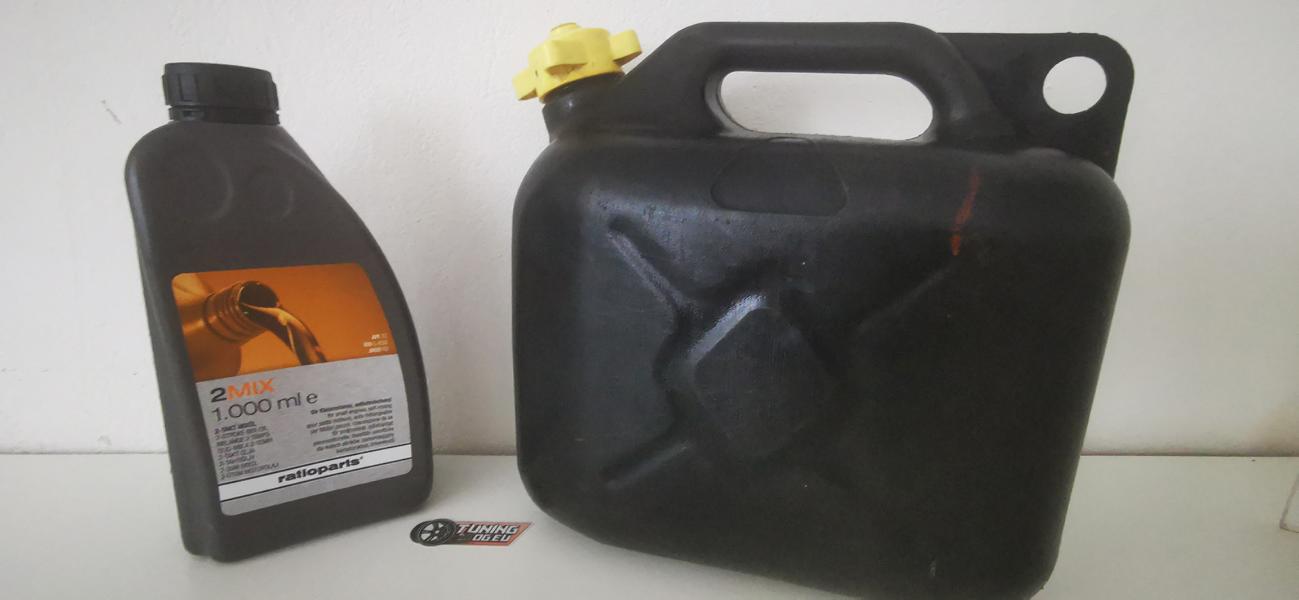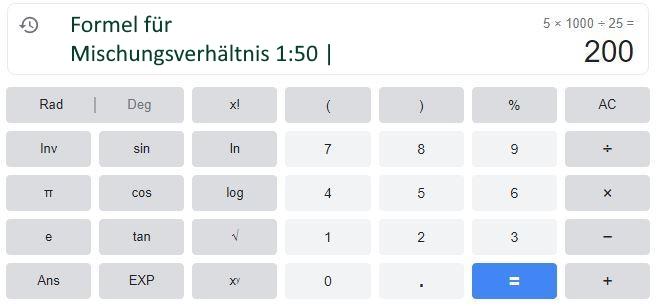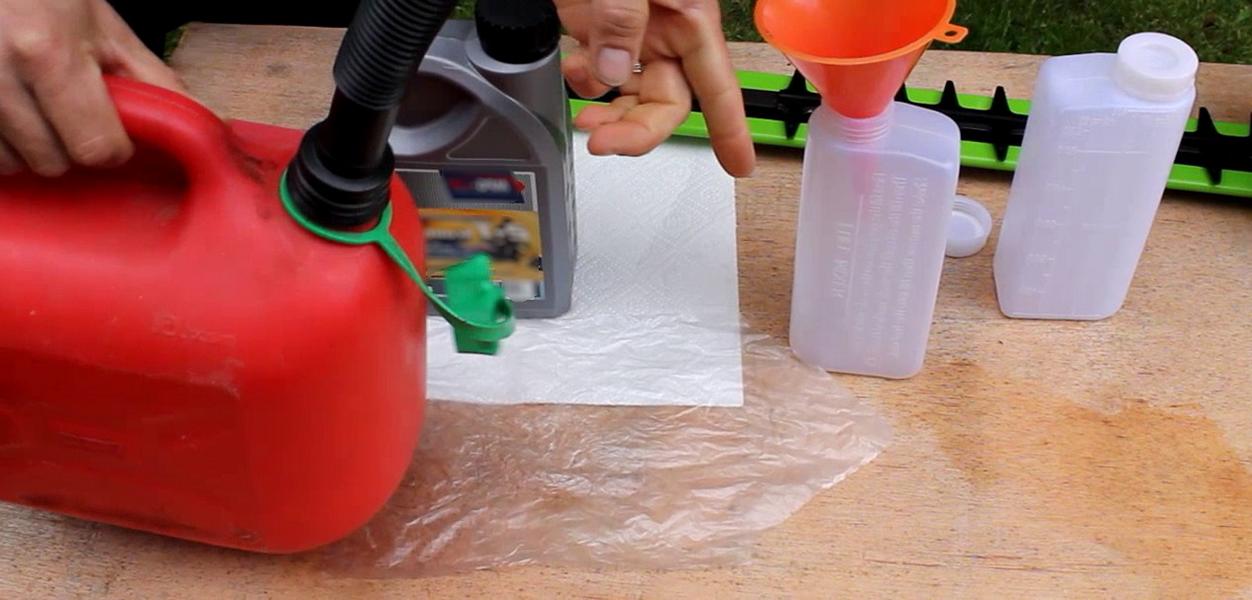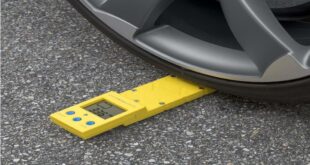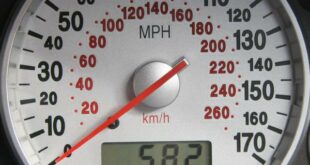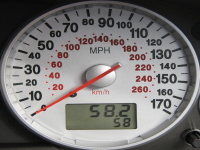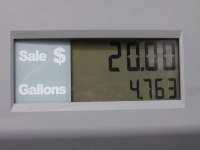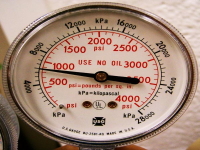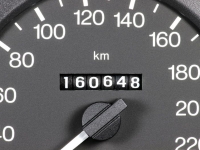Recently updated on October 24, 2023 at 02:33 am
[Update: 24.10.2023] This post was updatedto take more recent information into account. Even in times of electromobility, Euro 7 discussions and OPF filters, many mopeds, motorcycles and even cars are still like that Barkas, Trabant or the Wartburg on our roads with one Two-stroke mixture have to drive in the tank. However, a mixture may also be necessary away from vehicles. For example in a lawnmower, in a brush cutter (brush cutter), in a chainsaw and even various emergency power generators and RC burners are available with a 2-stroke mixture. So that you can mixing ratio don't have to do the math yourself, you can find one here Calculator for the oil percentage.
Oil Calculator – Mixing Ratio
In order to be able to determine the correct amount of oil, the following steps are necessary. In indicate the amount of gasoline that you want to fill up. After that, put the specific mixing ratio and select "Calculate". At the very bottom is the amount of oil you need for the specified amount of gasoline. And in some cases there is still a ready-mixed canister, but with the mixing ratio not fit. In this case the calculator is able to work out how much oil you are using still add have to. Of course it is necessary to know what the mixing ratio is in the canister. The perfect mixing ratio is determined by the manufacturer of the vehicle or the implement and can easily be found in the manual or on the Internet. In some cases it is too a sticker on the vehicle appropriate that provides information.
The usual mixing ratio for vehicle engines under normal load is included 1:50. Broken down it means that 50 parts of gasoline are added to one part of oil. The proportion of oil is around 2%. For engines under heavier conditions more lubrication is needed and the ratio is included 1:40 or even 1:33. For tools such as the aforementioned chainsaw, the brush cutter but also for RC burners the usual mixture is included 1: 25 or 1: 40.
even calculating yourself is not rocket science
In case you test your math skills and the mixing ratio want to calculate yourself, you will also find the correct formula for this. This is a simple division. To simplify matters, it is recommended that you put the gasoline part in Milliliters specify, i.e. the liters with 1000th multiply, After that divide The result with the larger number from the determined mixing ratio. The bottom line is that The amount of oil in milliliters that you need.
- Here's an example: With a mixing ratio of 1:50 and 5 liters to the petrol required, the following is calculated:
5 liters * 1000 = 5000 milliliters.
5000 milliliters / 50 = 100 milliliters.
So you have to 100 milliliters of oil Add to your gasoline to create a mixing ratio of 1:50 to obtain. - Important: Forget about it notthat you are well off your canister or tank after filling it with oil shake have to. The oil must mix properly, otherwise the engine may not be adequately lubricated.
- Ready mix: If you don't want to deal with the topic, you can do so directly Buy ready mix. Either in the online shop, at the gas station, the hardware store or a car dealership / car workshop.
There are also motorcycles, scooters or implements that require manual mixing is not necessary. Newer vehicles in particular have one Separate lubrication (also called fresh oil lubrication / loss lubrication). So one tank for the oil and one for the gasoline. The mixture is prepared itself and fed to the engine via a pump during operation. Often there are no constant mixing ratio, as the engine adds more or less oil depending on the load. In such a system, the dosage is regulated either depending on the position of the throttle grip or speed / load-dependent.
Common oils for separate lubrication
- Motul 710 2-stroke oil
- Castrol Power 1
- MANNOL 2-stroke universal
- Racing Dynamic Synthoil 2-stroke
- Motul 800 Off Road 2T
Not every 2-stroke oil is created equal. The area of application (scooter, chainsaw, classic car, etc.) is decisive. A motocross motorcycle should be refueled with a different 2-stroke oil than a scooter. And the 2-stroke oil for the chainsaw is usually different from that for the outrageously expensive old-timer at home in the garage. The greatest differences arise from the division into the varieties fully synthetic, partially synthetic and mineral. Mineral oil is the cheapest, followed by a semi-synthetic oil and the most expensive is a fully synthetic oil. In any case, it is essential: If 2-stroke oil is prescribed, then it must just such be used. So tilt no 4-stroke oil or gear oil as an alternative to the gasoline.
FAQ about mixing ratios
1. What does a mixing ratio of 1 to 50 mean?
- A mixing ratio of 1 to 50, often written as 1:50, means that 1 part of one substance is mixed with 50 parts of another substance. For two-stroke engines, for example, this means that for every 50 parts of gasoline there is 1 part of 2-stroke oil.
2. How much 2-stroke oil do I need for 1 liter of gasoline in a ratio of 1:50?
- With a mixing ratio of 1:50, add 1 ml of two-stroke oil to 20 liter of gasoline.
3. And how much 2-stroke oil do I need for 5 liters of petrol?
- For 5 liters of petrol you need 100 ml of two-stroke oil to Mixing ratio of 1:50 to achieve.
4. How do I calculate the mixing ratio?
- To calculate the mixing ratio, divide the total amount of solution by the desired ratio. For example: For 1 liter of solution with a dilution of 1:4, divide 1000 ml by 4, which gives 250 ml.
5. What does “1 in 50 refuel” mean?
- 1 in 50 fueling means you should mix 1 part two-stroke oil with 50 parts gasoline. This ratio ensures your engine is properly lubricated and performs to its maximum potential without risking damage.
6. Which oil should I use for a 1:50 mixture?
- For a Mixing ratio of 1:50 you should use a special 2-stroke oil. This can be regular petrol, super or super plus.
7. How much 2-stroke oil do I need for 2 liters of gasoline?
- This depends on the specific mixture ratio your engine requires. With a ratio of 1:100 you need 20 ml of oil for 2 liters of gasoline. With a ratio of 1:50 you will need 40 ml.
8. Which is better: a mixing ratio of 1 to 25 or 1 to 50?
- A pair of Mixing ratio of 1/50 usually provides adequate lubrication. A ratio of 1/25 is “richer” and can lead to higher emissions and faster engine fouling.
9. Which ratio is fatter: 1:40 or 1:50?
- 1:40 is richer than 1:50 because it contains 20% more lubricants compared to 1:50.
Note: It is always important to know your engine's specific needs and follow the manufacturer's recommendations to ensure your engine runs optimally and lasts a long time.
Of course, that wasn't the end of it!
tuningblog has countless other articles on the subject of car and auto tuning in stock. Do you want to see them all? Just click HERE and look around. In part, we would like to provide you with news but also off the tuning.
|
tuningblog.eu - Tire calculator - Tire circumference calculator! |
The power-to-weight ratio - all information about it and our calculator! |
Calculator: miles / hour (mph) in kilometers / hour (km / h) |
By the way: tuningblog has other options for Calculation of various things on-line. The following gallery provides an overview of all available computers:
 tuningblog.eu Your magazine about tuning the car
tuningblog.eu Your magazine about tuning the car
